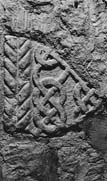Select a site alphabetically from the choices shown in the box below. Alternatively, browse sculptural examples using the Forward/Back buttons.
Chapters for this volume, along with copies of original in-text images, are available here.
Object type: Part of grave-cover[1]
Measurements: L. 35 cm (13.75 in) W. 35 cm (13.75 in) D. Built in
Stone type: [Lincolnshire Limestone but not Ancaster or Barnack types]
Plate numbers in printed volume: Fig. 14; Ill. 320
Corpus volume reference: Vol 5 p. 244
(There may be more views or larger images available for this item. Click on the thumbnail image to view.)
A fragment from the middle of a flat, rectangular or slightly tapering cover of Lindsey type decorated in low relief and only on the upper surface.
A (top): The border is defined by a twin cable moulding in a herringbone pattern and the central panel is occupied by the remains of two interconnecting lines of simple pattern F interlace, which produce a repetitive figure-of-eight pattern in two incomplete rows.
The figure-of-eight units measure 18.5 × 10.75 cm (7.25 × 4.25 in): the layout and spacing of the lines and rows appears regular. The decoration stands sharply as a squared U section against the flat cut-away background.
This is one of the interlace covers of Lindsey type discussed in Chapter V. It belongs to sub-group (a) distinguished by its double cable or herringbone border (Table 6). It shows the choice of good stone, controlled layout and fine finish characteristic of the sub-group. If its decoration was the normal three lines of interlace, the cover would have measured approximately 58.5 cm (23 in) in width, that is practically identical with the examples at Blyborough (no. 1, Ill. 53) and North Thoresby (Ill. 313) at the upper end of the size range of the cover type.



